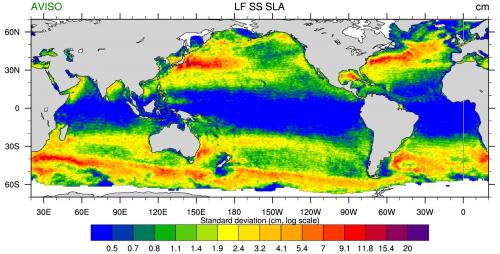Abstract's details
Which part of the low-frequency sea-level variability is purely due to intrinsic ocean processes ?
Event: 2015 Ocean Surface Topography Science Team Meeting
Session: Science III: Large scale and global change ocean processes: the ocean's role in climate
Presentation type: Poster
Altimetric observations are often interpreted by comparing them with Ocean General Circulation Model (OGCM) simulations in the turbulent regime, or with Coupled General Circulation Model (CGCM) simulations in which the ocean is generally laminar. Recent OGCM studies have highlighted that when the mesoscale is resolved, the ocean spontaneously generates erratic fluctuations causing strong low-frequency intrinsic sea-level variability over a wide range of spatial and temporal scales (Penduff et al. 2011, Sérazin et al. 2015) ; this nonlinear phenomenon is almost absent in the laminar regime, hence in most CGCM simulations. Using two eddying (1/4° and 1/12°) global OGCMs, we describe the imprint of this low-frequency intrinsic variability on three features of the oceanic circulation obversed by altimetry: interannual sea-level variance, regional sea-level trends, and Western Boundary Currents (WBCs) variability modes.
The interannual (i.e. from 1.5 to 20 years) small-scale (< 6°) intrinsic sea-level variance that spontaneously emerges under purely seasonal forcing is very comparable to that obtained in fully-forced hindcasts (i.e. with interannual forcing). These scales, which are the main contributor to low-frequency intrinsic variability, may be isolated in the 22-year record of altimetric data using a spatio-temporal filtering as done in Fig. 1. This low-frequency intrinsic variability also has a substantial imprint at larger scales (> 12°) and on the Atlantic Meridional Overturning Circulation (Gregorio et al., 2015).
The ocean spontaneously generates erratic sea-level fluctuations in eddy-active regions up to decadal-to-multidecadal timescales. This ocean-only variability has an imprint on observed regional sea-level trends, especially in the ACC and in the WBC areas. The truncation of this very low-frequency intrinsic variability in the current 22-year altimeter dataset yields an uncertainty in observed sea-level trends ; this eddy-induced uncertainty is actually comparable (and should be added) to that estimated from the Coupled Model Intercomparison Project 5 (CMIP5) simulations with laminar ocean models.
Finally, the spatial structure of the observed sea-level variability modes in WBCs, which is well simulated by our model with or without low-frequency forcing, is shown to be shaped by oceanic intrinsic processes. The temporal evolution of these spatial modes may be triggered by the low-frequency atmospheric forcing when present, leading to a longer memory than in the purely seasonally-forced case.

The interannual (i.e. from 1.5 to 20 years) small-scale (< 6°) intrinsic sea-level variance that spontaneously emerges under purely seasonal forcing is very comparable to that obtained in fully-forced hindcasts (i.e. with interannual forcing). These scales, which are the main contributor to low-frequency intrinsic variability, may be isolated in the 22-year record of altimetric data using a spatio-temporal filtering as done in Fig. 1. This low-frequency intrinsic variability also has a substantial imprint at larger scales (> 12°) and on the Atlantic Meridional Overturning Circulation (Gregorio et al., 2015).
The ocean spontaneously generates erratic sea-level fluctuations in eddy-active regions up to decadal-to-multidecadal timescales. This ocean-only variability has an imprint on observed regional sea-level trends, especially in the ACC and in the WBC areas. The truncation of this very low-frequency intrinsic variability in the current 22-year altimeter dataset yields an uncertainty in observed sea-level trends ; this eddy-induced uncertainty is actually comparable (and should be added) to that estimated from the Coupled Model Intercomparison Project 5 (CMIP5) simulations with laminar ocean models.
Finally, the spatial structure of the observed sea-level variability modes in WBCs, which is well simulated by our model with or without low-frequency forcing, is shown to be shaped by oceanic intrinsic processes. The temporal evolution of these spatial modes may be triggered by the low-frequency atmospheric forcing when present, leading to a longer memory than in the purely seasonally-forced case.
Contribution: OSTST_serazin_2015_compressed.pdf (pdf, 5294 ko)
Back to the list of abstract